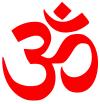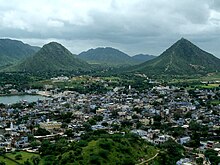Padma Purana

| Part ofa serieson |
| Hindu scriptures and texts |
|---|
 |
| Related Hindu texts |
ThePadma Purana(Sanskrit:पद्मपुराण or पाद्मपुराण,Padma-PuranaorPadma-Purana) is one of the eighteenMajor Puranas,a genre of texts inHinduism.It is an encyclopedic text, named after the lotus in which creator godBrahmaappeared, and includes large sections dedicated toVishnu,as well as significant sections onShivaandShakti.[1][2]
The manuscripts of Padma Purana have survived into the modern era in numerous versions, of which two are major and significantly different, one traced to eastern and the other to western regions of India.[3]It is one of the voluminous text, claiming to have 55,000 verses, with the actual surviving manuscripts showing about 50,000.[4][5]
The style of composition and textual arrangement suggest that it is likely a compilation of different parts written in different era by different authors.[6]The text includes sections on cosmology, mythology, genealogy, geography, rivers and seasons, temples and pilgrimage to numerous sites in India – notably to theBrahma Temple In PushkarRajasthan,[7]versions of story ofRamaandSitadifferent from one found inValmiki'sRamayana,festivals, glorification mainly of Vishnu but also in parts of Shiva and their worship, discussions on ethics and guest hospitality,Yoga,theosophical discussion onAtman(Soul),Advaita,Mokshaand other topics.[2][4][8]
There is Purana-style, but entirely differentJainismtext that is also known as Padma Purana and includes a Jain version of the Ramayana.[9][10]
History
[edit]ThePadma Purana,like other Puranas, exists in numerous versions.[11]One major recension, traced toBengalregion, has five Khandas (Parts, Books) and an appendix, but has neither been published nor translated.[3]The second major different recension, traced to western region of India, has six Khandas, is the adopted and oft-studied version since the colonial British India era.[3]The Bengal edition is older.[12]The Bengal edition is notable in that the 39 chapters on Dharma-sastra are missing from the Sristikhanda book, in all versions of its manuscripts.[6]
The composition date ofPadma Puranais unknown. Estimates vary between the 4th and 15th century CE.[13]Some parts of the text may be from the 750 to 1000 CE period.[14]The extant manuscripts and ones widely studied, states Wilson, is very likely to have been written or revised well after the 14th century, probably in the 15th or 16th century, because it describes later era major temple sites of south India and sites in theVijayanagara Empire.[4]No portion of the versions of thePadma Puranaavailable in the 19th century, wrote Wilson, is "probably older than the 12th-century".[4]Asoke Chatterjee, in 1963, suggested that the text may have existed between the 3rd and 4th century CE, but the text was rewritten and greatly expanded over the centuries and through the second half of the 17th century.[15]
Rocher states that the composition date of each Purana remains a contested issue.[16][17]Dimmitt and van Buitenen state that each of the Puranas manuscripts is encyclopedic in style, and it is difficult to ascertain when, where, why and by whom these were written:[18]
As They Exist Today, The Puranas Are A Stratified Literature. Each Titled Work Consists Of Material That Has Grown By Numerous Accretions In Successive Historical Eras. Thus, No Purana Has A Single Date Of Composition. (...) It Is As If They Were Libraries To Which New Volumes Have Been Continuously Added, Not Necessarily At The End Of The Shelf, But Randomly.
— Cornelia Dimmitt AndJ.A.B. Van Buitenen,Classical Hindu Mythology: A Reader In The Sanskrit Puranas[18]
ThePadma Puranacategorizes itself as aSattvaPurana (One Which Represents Goodness And Purity).[19]
Contents
[edit]
This text exists in two different versions (Recensions), the Bengal and the west Indian. The Bengal recension consists of Five Khandas (Sections): Shrishti Khanda, Bhumi Khanda, Svarga Khanda, Patala Khanda and Uttara Khanda.[20]The latter recension consists of Six Khandas: Adi Khanda (also known as the Svarga Khanda in some printed editions), Bhumi Khanda, Brahma Khanda, Patala Khanda, Srishti Khanda and Uttara Khanda. The Bhumi Khanda of the Bengal recension contains additional thirteen chapters, while the Patala Khanda of this recension contains thirty-one additional chapters. The Srishti Khanda can be divided into two parts and the second part is not found in the Bengal recension.[20]
The first eighteen chapters of the first part (Khanda) of the text is notable for its description of lakePushkar,nearAjmerinRajasthanas a Brahma pilgrimage site, followed by chapters with Vishnu-oriented presentation.[7]
The second part of the text is called Bhumikhanda, and is largely a book of legends woven into a pilgrimage guide.[7]The third part of the text, called Svargakhanda, presentsCosmology,geography of India, its rivers and description of places.[7]
The fourth part of the text, called Brahmakhanda, glorifies Vishnu, discusses seasons, festivals such as one dedicated to GoddessRadha,rituals and Tulasi plant.[7]The fifth part of the text, called Patalakhanda, presentsRamaas an Incarnation of Vishnu,Sitaas an Incarnation ofLakshmi,and presents a version of their story that is different from one found in the Valmiki'sRamayana.[21]The fifth part also includes chapters where Shiva andParvatidiscuss the character ofKrishna,as well as significant collection of chapters which glorify Shiva.[22]
The last part, called Uttarakhanda, contains legends and mythology associated with Indian festivals, eighteen chapters called as Gita Mahatmya, followed by chapters of Bhagavata Mahatmya and Shiva Gita, discussion of soul and liberation, quotes from theUpanishads,Yogaand theAdvaita Vedantadoctrines.[23]The text, in some versions of the manuscripts, ends with Kriya-Yogasara which is a discussion of ethics and hospitality to guests.[24]
Other texts with same title
[edit]Several purana-like texts of other Indian religions such asJainismandBuddhismare also known as Padma Purana. These include the Padma-Purana (also called Padma-Caritam) by the 7th century Ravisena of theDigambaratradition of Jainism, written in Sanskrit.[25]Other texts with same name include those by (Balabhadrapurana) or Raidhu (15th century), the Padma-Purana of Somadeva (1600), the Padma-Purana of Dharmakirti (1612), the Padma-Purana of Bhattaraka Candrakirti (c. 17th century), and two undated texts by Candrasagara and by Sricandra. These belong to theApabhramsagenre of Indian literature.[26]
References
[edit]- ^Dalal 2014,pp. 239–240.
- ^abRocher 1986,pp. 206–214.
- ^abcRocher 1986,pp. 18, 206–214.
- ^abcdWilson 1864,pp. 29–35.
- ^HH Wilson (1839),Essays on the Puránas. II,The Journal of the Royal Asiatic Society of Great Britain and Ireland, Vol. 5, No. 2, pages 280-313
- ^abRocher 1986,pp. 207–208.
- ^abcdeRocher 1986,pp. 208–209.
- ^K P Gietz 1992,pp. 289, 820.
- ^Rocher 1986,pp. 94–95, for context see 90-95 with footnotes.
- ^Dalal 2014,p. 240.
- ^Rocher 1986,pp. 18, 206–214;Bailey 2003,pp. 141–142.
- ^Rocher 1986,p. 207.
- ^Vanita 2005,p. 144.
- ^Doniger 2010,p. 473.
- ^K P Gietz 1992,pp. 287 with notes 1572-1574, 290 with note 1586.
- ^Rocher 1986,p. 249.
- ^Bailey 2003,pp. 139–141, 154–156.
- ^abDimmitt & van Buitenen 2012,p. 5.
- ^Wilson, H. H.(1840).The Vishnu Purana: A system of Hindu mythology and tradition.Oriental Translation Fund. p. 12.
- ^abHazra, R.C. (1962).The Puranasin S. Radhakrishnan ed.The Cultural Heritage of India,Calcutta: The Ramkrishna Mission Institute of Culture, Vol.II,ISBN81-85843-03-1,p.261
- ^Rocher 1986,p. 209.
- ^Rocher 1986,pp. 209–211.
- ^Rocher 1986,pp. 211–213.
- ^Rocher 1986,p. 213.
- ^Kodaganallur Ramaswami Srinivasa Iyengar (2005).Asian Variations in Ramayana: Papers Presented at the International Seminar on 'Variations in Ramayana in Asia.Sahitya Akademi. pp. 58, 70.ISBN978-81-260-1809-3.
- ^Devi Prasada Mishra, cited in Kodaganallur Ramaswami Srinivasa Iyengar,Asian variations in Ramayana,Sahitya Akademi (2006)ISBN9788126018093,p. 61.
Bibliography
[edit]- Bailey, Gregory (2003). Arvind Sharma (ed.).The Study of Hinduism.University of South Carolina Press.ISBN978-1-57003-449-7.
- Dimmitt, Cornelia; van Buitenen, J. A. B. (2012).Classical Hindu Mythology: A Reader in the Sanskrit Puranas.Temple University Press (1st Edition: 1977).ISBN978-1-4399-0464-0.
- Doniger, Wendy (2010),The Hindus: An Alternative History,Oxford University Press
- Dalal, Rosen (2014).Hinduism: An Alphabetical Guide.Penguin.ISBN978-8184752779.
- K P Gietz; et al. (1992).Epic and Puranic Bibliography (Up to 1985) Annoted and with Indexes: Part I: A - R, Part II: S - Z, Indexes.Otto Harrassowitz Verlag.ISBN978-3-447-03028-1.
- Rocher, Ludo(1986).The Puranas.Otto Harrassowitz Verlag.ISBN978-3447025225.
- Vanita, Ruth (2005).Love's Rite.Palgrave Macmillan.ISBN978-1-4039-8160-8.
- Wilson, H. H.(1864).Puranas.Read Books.ISBN1-84664-664-2.
External links
[edit]- Padma Purana Part 1 Srishti Khanda Motilal Banarsidass 1988
- Padma Purana Part 2 Srishti Khanda Motilal Banarsidass 1989
- Padma Purana Motilal Vol. 3 Through Vol. 10
- THE PADMA-PURANA PART. 3
- Padma Purana Vol 04 Bhumi And Svarga Khanda Pages 1241 1563 ENG Motilal Banarsidass 1990
- The Padma PuranaEnglish translation by N. A. Deshpande, 1951 (includes glossary)
- Ethics And Sociology Of Politics In Some Of The PuranasVR Varma (1978), The Indian Journal of Political Science (discusses Padma Purana)
- Essays On The Puranas. IIHH Wilson (1839), The Journal Of The Royal Asiatic Society Of Great Britain And Ireland (Discusses Pilgrimage In Padma Purana)

